ASgt Gerald Norman Magee (B 46535) (1921–45)
Introduction
My introduction to many of the Argylls on the Roll of Honour came in the 1980s from veterans, men whom I invariably respected. I met Pte Tom Sayer several times over the years, and I recall a memorable occasion in 1986 when Lt-Col Dave Stewart, the Argylls’ greatest leader, returned for a Regimental reunion. Tom was there and his brother Les as well. There were innumerable conversations and stories as well as reflective moments. Tom was a tough soldier, a brave Argyll whom many thought should have been decorated for his selfless heroism in getting the wounded out of the Hochwald Gap in late February 1945. When we interviewed Tom, he talked about Sgt Gerald Magee. It was a short meditation, I thought, on goodness as an Argyll and as a man. Sgt Magee’s name has never left me. Thank you, Tom Sayer (and also Hugh Maclean). He was there for so long; he left so little, but men such as Sayer and Maclean never forgot him – high praise, indeed. So far, I have not found an image or family, but we do have his record and his memory – Albainn Gu Brath.
Robert L. Fraser
Regimental Historian
Death in battle is different, Sam Chapman thought:
“He is cut down in an instant with all his future a page now to remain forever blank.
There is an end but no conclusion.”
– Capt Sam Chapman, C and D Coys
ASgt Gerald Norman Magee (B 46535) (1921–45)
KIA 18 April 1945
“We had a good man, a good man. Gerald his name was – Magee – and a good man”
Gerald Norman Magee was born at Women’s College Hospital in Toronto to George Henry Magee and Minnie (Mary) Elizabeth Johnston on 21 August 1921; they had married in St Boniface, Manitoba, on 16 August 1913. Born, apparently, in Belfast, George Magee had immigrated to Canada in 1909. At some point, Henry and Minnie moved to Toronto and began a family; Gerald had one brother and three younger sisters. Magee had four years of high school but did not graduate. Working as a silkscreen printer at Brigden’s Limited Engravers in Toronto, he lived at home with his mother and his younger sister.
For whatever reason, Magee’s personnel file contains none of the usual interview and personnel selection forms that so often provide some sense of an enlistee’s life. In July 1940, he had joined the 2nd Battalion, 48 Highlanders. He enlisted with the Argylls on 28 December 1940 at Chippewa Barracks. The young Baptist was 5’ 8½”, 125 lb, with “green brown” eyes and brown hair. Magee’s introduction to soldiering took him from guard duty in the Niagara peninsula to training at Camp Nanaimo in British Columbia from May to August in 1941, 21 months in Jamaica, a return to Niagara Camp in May 1943, 10 days’ leave in early June, and then overseas to the United Kingdom in July 1943. He witnessed the transformation of the 1st Battalion from 800 or so men with First War uniforms, rifles, and equipment, and a tenuous grasp of military life and organization, to a well-trained, well-administered, and well-led force of healthy, fit, young men.
Serving with B Company as a private, Magee rose in rank overseas. He was promoted acting corporal on 1 August 1943 at Camberley; confirmed a corporal on 4 November at Riddlesworth Camp in Norfolk; and rose to an acting sergeant on 25 March 1944 at Uckfield in Sussex. At some point in early 1944, he joined the Scout Platoon commanded by Lt John Lloyd Johnston. The Scouts attracted the more ardent and adventurous Argylls. Magee landed in France with the Scouts on 22 July 1944.
“a platoon who can smell out Gestapo headquarters from any direction”
The Scouts were continuously involved in the fighting of early August and often at night. For Lt Mac Smith (Intelligence Officer and then Adjutant), Johnston was “about the best officer in the C.A.O.” and “has a platoon who can smell out Gestapo headquarters from any direction and who return laden with strange souvenirs like the occasional bottle of Cointreau, Benedictine or Triple Sec.”
Johnston and the Scouts distinguished themselves at Hill 195. Lt-Col Dave Stewart, the commanding officer, and Johnston took the Scouts up the slope, leaving picquets to mark the way. Later, Stewart led the four rifle companies single file in the dark up the rise, infiltrating the German lines in the dead of night on 10–11 August 1944. It proved a success – a brilliantly unorthodox battalion-scale infiltration of the hitherto unassailable enemy strongpoint. The path was clear to Falaise and beyond.
“multiple minor splinter” wounds
The Scouts and A Coy provided a diversionary attack north of the bridge at Moerbrugge from 8 to 10 September [see Pte Welby Lloyd Patterson]. Magee was wounded on the first day of the struggle at Moerbrugge, receiving “multiple minor splinter” wounds to his legs and left hand from an 88mm “HE [high explosive] round. He was seen first by a medical officer and then admitted to 15 Canadian Field Ambulance at 1800 hours. From there he went to 12 Field Dressing Station, where he was treated. At 2230 hours, “his Condition [was] Good.” Magee was discharged on 15 September, telegrams were sent to his father on the 20th and the 25th, and he returned to the unit on 3 October. Lloyd Johnston’s death on 14 September had devastated the platoon; they lost young Pte Paul Cole on the 19th.
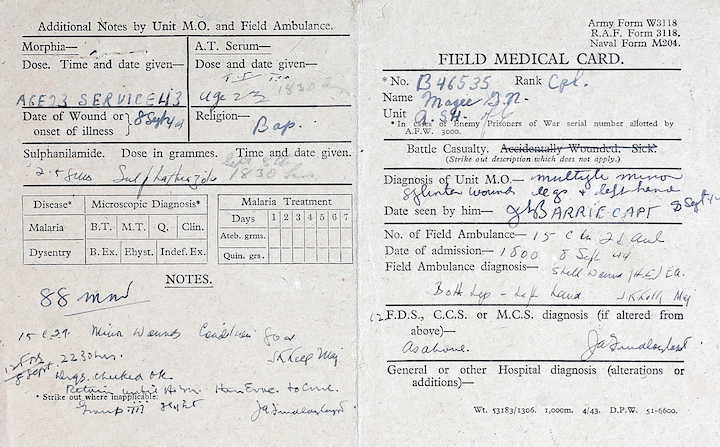 Field medical card, Cpl G.N. Magee.
Field medical card, Cpl G.N. Magee.
 Telegram to Cpl Magee’s father, 20 September 1944.
Telegram to Cpl Magee’s father, 20 September 1944.
 Telegram to Cpl Magee’s father, 25 September 1944.
Telegram to Cpl Magee’s father, 25 September 1944.
“he used to have his own prayer meetings with the guys”
Magee was a stalwart of the Scouts over the next six months. His service record is spotless, not one infraction, which is a rarity. Magee was a different sort. Pte Tom Sayer, B Company, recalled:
… he used to have his own prayer meetings with the guys. If they were going into an attack, he would say, “Well, I’m going to pray for good keeping, good luck and all the help that He can give us. Anybody want to join me?” And he’d [gather] with the guys and he’d pray with them, and he didn’t drink or anything like that.
“a brave, cool soldier”
Magee made it through the fighting of October and early November; the cold winter’s respite of sorts on the Maas River [see Pte Alex Eli Laba]; the battle of Kapelsche Veer [see Pte Donald Douglas MacKeracher]; and the fight into Germany through the Hochwald Gap to Veen [see LCpl Frederick Woodward Jr and Pte Clarence Richard Vaise]. The fighting from mid-April to early May resulted in heavy casualties; Magee was one of them; he was killed on 18 April 1945 at the Küsten Canal. Maj Hugh Maclean, the officer commanding Support Company, wrote the 1st Battalion’s history in the summer of 1945. He himself had been in the thick of it at the canal. He wrote compellingly of Magee’s last, and fatal, battle:
‘C’ Company got over [the canal] just before first light and took position along the canal to the left of ‘A’ Company, thus filling the gap between ‘A’ and ‘D’. This position was no sooner occupied than an attack was made on ‘C’ company by German infantry from the northwest. Due to the early morning mist and to the fact that the men of the company were still getting established, this attack was not observed until the Germans were less than 100 yards away. Weapons were hurriedly brought into action and spirited fighting lasted for upwards of an hour, in the course of which many Germans were killed. The remainder eventually drew off, but individual snipers continued to harass the Canadians from the fields in front and to a flank.
“one of the most popular members of the unit since 1940”
The unit war diarist described Sgt Magee “C Company” as “one of the most popular members of the unit since 1940” and pronounced him killed by “machine-gun fire.” Lt Doug Beale of C Coy referred to him as:
a sergeant of the Scout Platoon … in that same action with us. He crossed over with us, and his slit trench was right on the edge of this embankment around this big barnyard, and one of these mortars hit right beside him killing him instantly.
“In this attack,” Maclean lamented, “was killed Sgt. Magee, a brave, cool soldier who had only a few days before transferred from the scout platoon, whose main reliance and stay he had been for months.”
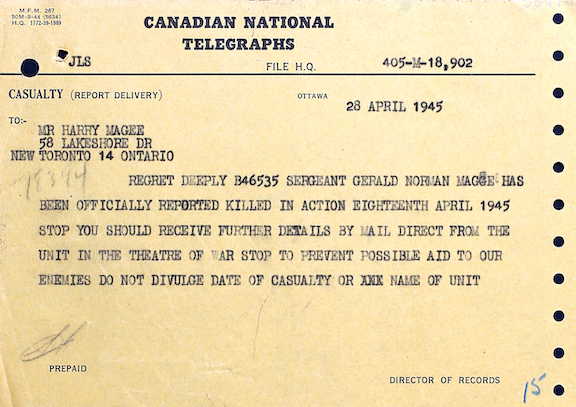 Telegram sent to Sgt Magee’s father, Harry Magee, 28 April 1945, informing him that his son was killed in action.
Telegram sent to Sgt Magee’s father, Harry Magee, 28 April 1945, informing him that his son was killed in action.
“Gerald my boy who was killed in Germany”
On 22 May 1945, Magee’s incredulous mother wrote to the Director of Records expressing her dismay that “there should be anything addressed” to her husband:
I’m sorry to say Gerald’s father and I have been separated for quite a while as his love for drink has taken away any sense of responsibility to support my little girl who is only fourteen or I for a long time.
A few months prior to his death, she explained, Magee had been “trying to get me Dependants allowance” and had “conversed with his Commanding Officer and Padre regarding giving some more personal assistance to his mother.” She noted that from Gerald’s enlistment to the present “his father has never written to him, so I’m sure Gerald if he was living to-day, would consider his dad the last one in the world whom he could trust with anything belonging to him[.]”
“he was the chum of my son Paul Cole who was killed”
Helena Cole, Pte Paul Cole’s mother, sent a note to “Army H. Ottawa” from her Picton home on 3 June:
I have been informed that B46535 Magee G.N. l Bn A&SH. CAO is dead I wish to write his mother living in Toronto and would be thankful for her Address as he was the chum of my son Paul Cole who was killed[.]
Mrs Cole’s brief comment supports Maclean’s statement that Magee had been the Scouts’ “main reliance and stay for months.”
This good religious man was buried by a good and religious man, Padre Charlie Maclean. Magee left little: a letter, “snapshots,” a souvenir German pin and a pair of wooden shoes, 2 rings, 3 pens, a broken watch, a copy of the New Testament, and a “Religious” booklet. Pte Tom Sayer, a brave Argyll, never forgot Sgt Magee:
We had a good man, a good man. Gerald his name was – Magee – and a good man … a religious sort of fellow; never drank or anything like that. But he got to be a sergeant, and he was a brave man, a religious man. He used to have his own prayer meetings with the guys. If they were going into an attack, he would say ‘well, I’m going to pray for good keeping, good luck and all the help that He can give us. Anybody want to join me? And he’d [gather] the guys and he’d pray with them, and didn’t drink or anything like that.
“why was the good man taken and the other guy not taken, eh?”
Magee’s fate bewildered Pte Tom Sayer. Magee had been with another Argyll at the time of his death:
“Boy, was he great. And he was rough, tough, and ignorant. Both of them running side by side … Magee gets killed, [the other Argyll] doesn’t. Now, why was the good man taken and the other guy not taken, eh?”
Sayer reached his own conclusion: “Everybody looked after everybody else. But there was not [a] divine person doing it.” Over 40 years after Magee’s death, Pte Tom Sayer underscored the essential goodness of Gerald Norman Magee as a soldier and as a man – “a good man, a good man … and a good man” is not a bad epitaph for anyone.
Between 15 and 18 April 1945, 9 Argylls were killed in action, 38 wounded, and 2 POWs.
“a history bought by blood” – Capt Sam Chapman, C and D Coys
Remembered respectfully – An Argyll
Note: ASgt Magee’s poppy will be mounted in the virtual Argyll Field of Remembrance in the near future. The Argyll Regimental Foundation (ARF) commissioned Lorraine M. DeGroote to paint the Argyll Poppy (at top and below) for the Field of Remembrance.
Robert L. Fraser
Regimental Historian

 Brigden’s Limited, c. 1912.
Brigden’s Limited, c. 1912.
 Capt John Lloyd Johnston.
Capt John Lloyd Johnston.
 Scout Platoon in France, August 1944.
Scout Platoon in France, August 1944.
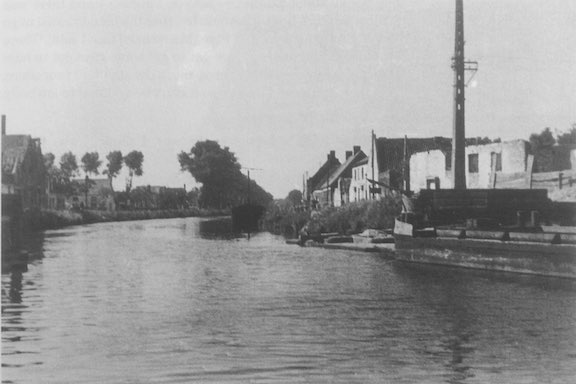 Ghent Canal, Moerbrugge.
Ghent Canal, Moerbrugge.
 CSM George Mitchell, C Coy, noted on the back of this picture: “A view of the side of the canal we had to cross to.”
CSM George Mitchell, C Coy, noted on the back of this picture: “A view of the side of the canal we had to cross to.”
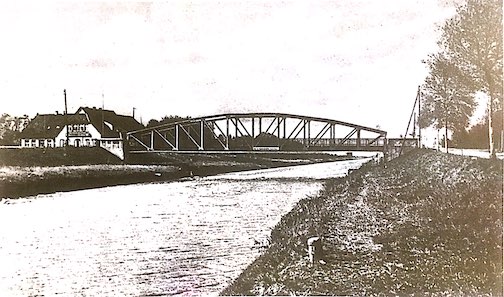 Crossing site, Küsten Canal.
Crossing site, Küsten Canal.
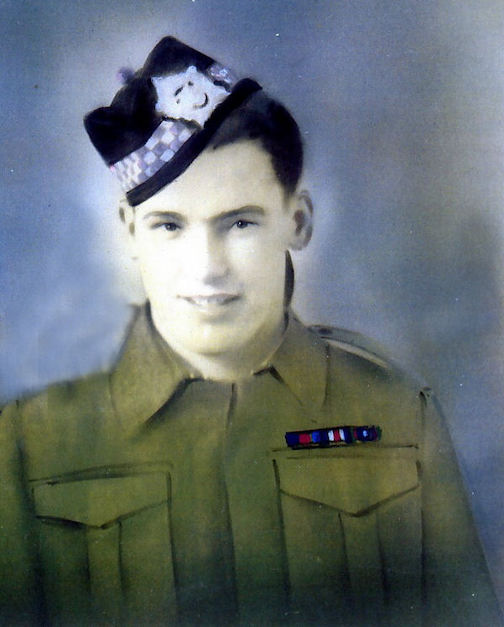 Helena Cole’s son, Pte Paul Joseph Cole.
Helena Cole’s son, Pte Paul Joseph Cole.
 Letter from Helena Cole to Army HDQ in Ottawa, 3 June 1945.
Letter from Helena Cole to Army HDQ in Ottawa, 3 June 1945.
 Grave marker, Sgt Gerald Norman Magee, Holten Canadian War Cemetery.
Grave marker, Sgt Gerald Norman Magee, Holten Canadian War Cemetery.